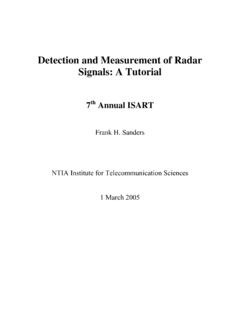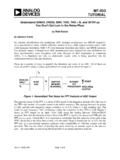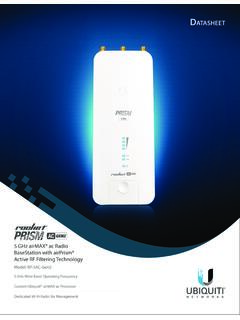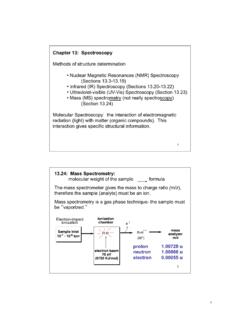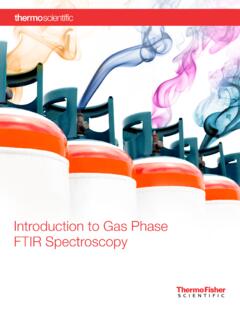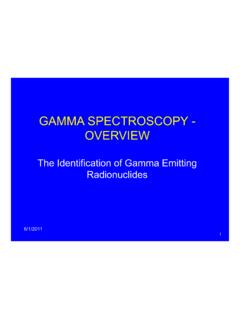Transcription of Spectrum Analyzer Basics - Indian Institute of Technology ...
1 Spectrum Analyzer Basicswww. Analyzer BasicsAbstractLearn why Spectrum analysis is important for a variety of applications and how to measure system and device performance using a Spectrum Analyzer . To introduce you to Spectrum analyzers, the theory of operation will be discussed. In addition, the major components inside the Analyzer and why they are important will be examined. Next, you will learn the Spectrum Analyzer specifications that are important for your application. Finally, features of a Spectrum Analyzer that make it more effective in making measurements will be Analyzer Overview: What is Spectrum analysis? What measurements do we make? Theory of Operation: Spectrum Analyzer hardware Specifications: Which are important and why?
2 Features Making the Analyzer more effective Summary AppendixSlide 1 This paper is intended to be a beginning tutorial on Spectrum analysis. It is written for those who are unfamiliar with Spectrum analyzers, and would like a basic understanding of how they work, what you need to know to use them to their fullest potential, and how to make them more effective for particular applications. It is written for new engineers and technicians, therefore a basic understanding of electrical concepts is recommended. We will begin with an overview of Spectrum analysis. In this section, we will define Spectrum analysis as well as present a brief introduction to the types of tests that are made with a Spectrum Analyzer .
3 From there, we will learn about Spectrum analyzers in terms of the hardware inside, what the importance of each component is, and how it all works order to make measurements on a Spectrum Analyzer and to interpret the results correctly, it is important to understand the characteristics of the Analyzer . Spectrum Analyzer specifications will help you determine if a particular instrument will make the measurements you need to make, and how accurate the results will analyzers also have many additional features that help make them more effective for particular applications. We will discuss briefly, some of the more important and widely used features in this finally, we will wrap up with a Analyzer Overview Theory of Operation Specifications Features Summary AppendixSlide 2 Let's begin with an overview of Spectrum Analyzer is Spectrum Analysis?
4 8563 ASPECTRUM Analyzer 9 kHz - 2 GHzSlide 3If you are designing, manufacturing, or doing field service/repair of electrical devices or systems, you need a tool that will help you analyze the electrical signals that are passing through or being transmitted by your system or device. By analyzing the characteristics of the signal once its gone through the device/system, you can determine the performance, find problems, troubleshoot, etc. How do we measure these electrical signals in order to see what happens to them as they pass through our device/system and therefore verify the performance? We need a passive receiver, meaning it doesn't do anything to the signal - it just displays it in a way that makes it easy to analyze the signal.
5 This is called a Spectrum Analyzer . Spectrum analyzers usually display raw, unprocessed signal information such as voltage, power, period, waveshape, sidebands, and frequency. They can provide you with a clear and precise window into the frequency Spectrum . Depending upon the application, a signal could have several different characteristics. For example, in communications, in order to send information such as your voice or data, it must be modulated onto a higher frequency carrier. A modulated signal will have specific characteristics depending on the type of modulation used. When testing non-linear devices such as amplifiers or mixers, it is important to understand how these create distortion products and what these distortion products look like.
6 Understanding the characteristics of noise and how a noise signal looks compared to other types of signals can also help you in analyzing your device/system. Understanding the important aspects of a Spectrum Analyzer for measuring all of these types of signals will help you make more accurate measurements and give you confidence that you are interpreting the results Analyzer of Tests 4 The most common Spectrum Analyzer measurements are: modulation, distortion, and the quality of the modulation is important for making sure your system is working properly and that the information is being transmitted correctly. Understanding the spectral content is important, especially in communications where there is very limited bandwidth.
7 The amount of power being transmitted (for example, to overcome the channel impairments in wireless systems) is another key measurement in communications. Tests such as modulation degree, sideband amplitude, modulation quality, occupied bandwidth are examples of common modulation communications, measuring distortion is critical for both the receiver and transmitter. Excessive harmonic distortion at the output of a transmitter can interfere with other communication bands. The pre-amplification stages in a receiver must be free of intermodulation distortion to prevent signal crosstalk. An example is the intermodulation of cable TV carriers that moves down the trunk of the distribution system and distorts other channels on the same cable.
8 Common distortion measurements include intermodulation, harmonics, and spurious is often the signal you want to measure. Any active circuit or device will generate noise. Tests such as noise figure and signal-to-noise ratio (SNR) are important for characterizing the performance of a device and/or its contribution to overall system all of these Spectrum Analyzer measurements, it is important to understand the operation of the Spectrum Analyzer and the Spectrum Analyzer performance required for your specific measurement and test specifications. This will help you choose the right Analyzer for your application as well as get the most out of Analyzer versus Time DomaintimeAmplitude(power)frequencyTime domainMeasurementsFrequency DomainMeasurementsSlide 5 Traditionally, when you want to look at an electrical signal, you use an oscilloscope to see how the signal varies with time.
9 This is very important information; however, it doesn't give you the full picture. To fully understand the performance of your device/system, you will also want to analyze the signal(s) in the frequency-domain. This is a graphical representation of the signal's amplitude as a function of frequency The Spectrum Analyzer is to the frequency domain as the oscilloscope is to the time domain. (It is important to note that Spectrum analyzers can also be used in the fixed-tune mode (zero span) to provide time-domain measurement capability much like that of an oscilloscope.)The figure shows a signal in both the time and the frequency domains. In the time domain, all frequency components of the signal are summed together and displayed.
10 In the frequency domain, complex signals (that is, signals composed of more than one frequency) are separated into their frequency components, and the level at each frequency is displayed. Frequency domain measurements have several distinct advantages. For example, let's say you're looking at a signal on an oscilloscope that appears to be a pure sine wave. A pure sine wave has no harmonic distortion. If you look at the signal on a Spectrum Analyzer , you may find that your signal is actually made up of several frequencies. What was not discernible on the oscilloscope becomes very apparent on the Spectrum Analyzer . Some systems are inherently frequency domain oriented. For example, many telecommunications systems use what is called Frequency Division Multiple Access (FDMA) or Frequency Division Multiplexing (FDM).
